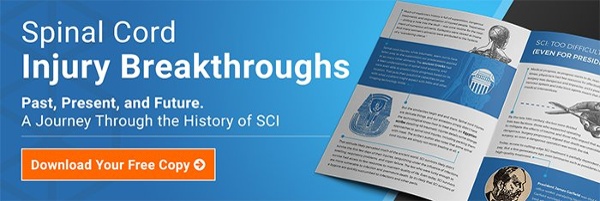Top 4 Reasons to Be Excited About Spinal Cord Injury Research
Spinal cord injury (SCI) research has exploded in the last 20 years. We've all watched it grow with glee, especially those of us with a vested interest in it. Over the last five years, it has really gained traction with a handful of research programs showing excellent results. We've compiled four of the most exciting developments below.
After seeing how amazing SCI research is currently, we hope all of you are hopeful as we are that a treatment that returns some or all motor and/or sensory functions will be available in the near future.
1. Neural Implants
One of the most futuristic developments in spinal cord injury research has been the advent of brain implants. ![]() At Ohio State’s Center for Neuromodulation in 2016, Ian Burkhardt underwent a successful surgery in which doctors successfully implanted a chip in his brain that reads brain signals and communicates through a computer on his sleeve. With the implant, Ian is able to use move his hands and open them, which is something he wasn’t able to do as a result of his injury five years prior.
At Ohio State’s Center for Neuromodulation in 2016, Ian Burkhardt underwent a successful surgery in which doctors successfully implanted a chip in his brain that reads brain signals and communicates through a computer on his sleeve. With the implant, Ian is able to use move his hands and open them, which is something he wasn’t able to do as a result of his injury five years prior.
With practice and repetition over a year, Ian has been able to play guitar, pour the liquid from a bottle and pick up a straw and stir. He is now classified a C7 instead of his previous level, C5.
2. Genetic Therapy
Gene therapy is providing hope for all kinds of diseases and conditions, and spinal cord injury research is just one area of medicine that it’s being applied to. At the Spinal Cord Injury Research Facility at Auckland University, SCI research technician Jared Griffin received a $100,000 grant to explore the possibilities of healing paralysis through this “programmable” type of therapy.
The therapy works by inserting genes into damaged spinal cord tissue that allow the motor neurons to regrow and, hopefully, restore function. So far, Griffin has been able to replicate an earlier study that was able to remove scar tissue around the spinal cord injury using gene therapy.
3. Epidural Stimulation Therapy
One of the most exciting developments to happen in spinal cord injury research is epidural stimulation. This procedure, which uses a continuous electrical current at different frequencies to stimulate the spinal cord to reawaken its neural processes, was discovered by Dr. Susan Harkema at the University of Kentucky (click to tweet!). Her research, the “Effect of Epidural stimulation of the lumbosacral spinal cord on voluntary movement, standing, and assisted stepping after motor complete paraplegia: a case study” was published in 2011. It works by implanting a simulator into the spinal cord, which can be turned on/or off via remote by the patient.
When the chip is turned on, the ongoing electrical stimulation connects the brain impulses to the targeted muscle, and has been able to help individuals with paraplegia regain some leg movement, such as the ability to sit up without support or stand using a walker, as well as the return of some bladder, bowel and sexual functions. The Christopher and Dana Reeve Foundation is a big supporter of epidural stimulation and promotes the research with its “The Big Idea” initiative.
4. Asterias Biotherapeutics (and Stem Cells)
We’ve all heard about stem cell research, but Asterias Biotherapeutics is taking it to another level: they’re conducting human trials right here in the U.S. They choose newly injured individuals to be part of the study and each person is injected with 10 million human embryonic stem cells (hESC-derived Oligodendrocyte Progenitors) into their spinal cords. ![]()
So far, 35 patients have participated in the study, which it is being conducted at six locations around the country. They’ve seen positive results in many of the participants, and the researchers and patients are committed to the research for the long haul.
Who knows what lies just around the corner for the future of spinal cord injury research in the next 5-10 years? With research like what has been talked about the four areas above, it really does feel like the “impossible” may one day come true.
What area of research do you think holds the most promise?
Stay Updated on Advancements On Traumatic Brain &
Spinal Cord Injuries
About the Author





